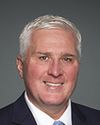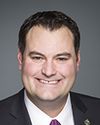Good afternoon, Chair and members of the committee. I'm pleased to return to the Standing Committee on Veterans Affairs to discuss the 2016-17 supplementary estimates (B) to Parliament on behalf of Veterans Affairs Canada.
Let me preface my remarks before this committee with an observation of the debt Canada owes its men and women in uniform. Veterans Affairs Canada is working hard to provide veterans and their families with the care and supports they need, when and where they need it.
We're also working to engage Canadians in commemorating all who have served. Last year, the Prime Minister gave me a mandate to ensure that our government lives up to its obligation to veterans and their families. The department has done a lot of work over the past year and has delivered on a number of the priorities in my mandate letter. These supplementary estimates reflect those accomplishments and the work that remains to be done.
My first year as Minister of Veterans Affairs and Associate Minister of National Defence has been rewarding, albeit challenging. I've travelled across the country and I've met outstanding people: older veterans and younger veterans, as well as current members of the Canadian Armed Forces, who will one day become veterans. They have shared their stories and their struggles. I have learned so, so much.
I have learned that while 73% of veterans successfully transition from military to civilian life, 27% of them struggle. They need our help. That is why our department is here, and it's where we're at. This is the reality that we face, and there is no silver bullet. We will make incremental changes and find better and better ways to help veterans rebuild their lives. As a country, we must provide that help.
We are transforming the way the Department of Veterans Affairs works, improving the way we deliver services to veterans and their families. That's the purpose of this supplementary allocation. For this year's supplementary estimates for Veterans Affairs Canada, this supplementary allocation will provide $130 million in funding. This 3.6% increase over the current budget increases it from $3.64 billion to $3.77 billion. These funds will help our government fulfill its commitment to Canada's veterans.
What is the additional allocation for? It will be used to move forward on our stated and approved initiatives, to move forward on the goal of ensuring that we live up to our obligations to our men and women in uniform. These include: increasing the value of the disability award from $310,000 to $360,000; enhancing the earnings loss benefit from 75% to 90% of an injured veteran's pre-release salary; enhancing the permanent impairment allowance so that veteran is appropriately compensated for the impact of a service-related impairment on his or her career; reopening the nine Veterans Affairs offices across the country, with an additional one in Surrey, British Columbia, and extending mobile outreach in Canada's north to ensure we are serving our first nations, Métis, and Inuit veterans adequately; and, hiring more staff to improve delivery of much-needed services to veterans, including hiring more case managers. Each case manager's workload will be, on average, 25 cases to one manager.
The commemoration of Canada's men and women in uniform and of their accomplishments is a key part of Veterans Affairs' responsibilities. That's why the supplementary allocations include funds to commemorate major milestones of the First and Second World Wars, in 2017, the same year in which we will celebrate Canada's 150th birthday.
Events will be held in Canada and France to mark the centennial of the Battle of Vimy Ridge next year. Commemorative ceremonies and events will be held at the Canadian National Vimy Memorial in France, at the national war memorial in Ottawa, and in communities across the country on April 9. Major milestone events will also be held to mark the centennial of the Battle of Passchendaele and the 75th anniversary of the Battle of Dieppe.
The estimates also include an increase in the funeral and burial program that is administered by the Last Post Fund, which provides financial assistance for funeral and burial services, including grave markings for eligible veterans. This will make it easier for veterans' families to provide a dignified funeral and burial for their loved ones.
In addition, there's an allocation for the 2017 Invictus Games in Toronto, which will be the host city for this international sporting competition for ill and injured military members and veterans. It leverages the rehabilitative powers of sport to honour the men and women who have come face to face with the reality of sacrificing for their country. Team Canada will proudly represent the host country with a roster made up of as many as 90 active Canadian Armed Forces members and veterans.
Finally, the allocation includes a request resulting from the Treasury Board submission for the transfer of Ste. Anne's Hospital from federal to provincial authority.
Veterans Affairs Canada has accomplished a great deal over the past year, but there is still much more to do, and we are working with the Department of National Defence to reduce the complexity of the transition from Canadian Armed Forces member to veteran. We are also working closely with veterans groups and stakeholders to ensure that we get it right on the other items on the priority list, including the re-establishment of an option for a lifelong pension.
All the funding in supplementary estimates (B) has been previously approved by Treasury Board. Our meeting today is simply to have the funding added to the department's current budget. This will allow the department to move forward on its initiatives, with the overarching goal of ensuring Canada's veterans receive the respect, support, care, and economic opportunities they deserve.
Thank you so much for being here today, and thank you so much for your hard work on this committee. It is greatly appreciated.










